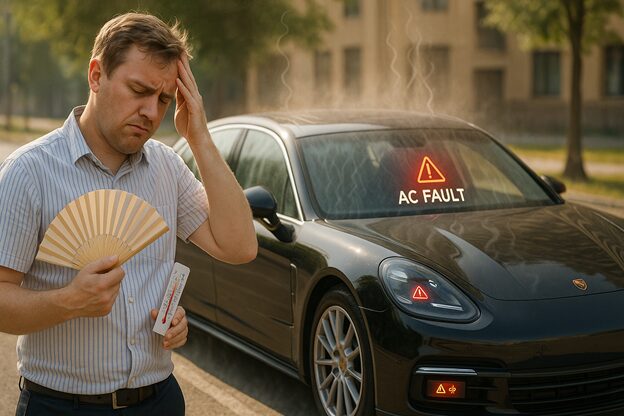5 AC Cooling Problems Porsche Owners Face in UAE Summers
The UAE’s relentless summer heat transforms air conditioning from a luxury feature into an absolute necessity for vehicle operation. For Porsche owners throughout the Emirates, the sophisticated climate control systems in their vehicles face extraordinary challenges that push these advanced systems beyond their design parameters. When ambient temperatures soar above 50°C and dashboard surfaces reach scorching levels that can exceed 80°C, even the most advanced German-engineered cooling systems can struggle to maintain optimal performance. Understanding the most common AC-related issues that plague Porsche vehicles during UAE summers can help owners recognize early warning signs, implement preventive measures, and seek appropriate professional intervention when necessary.

1. Compressor Overload and Premature Failure
The heart of any automotive air conditioning system, the compressor, faces unprecedented stress levels in UAE summer conditions. Porsche vehicles, with their advanced multi-zone climate control systems and high-performance expectations, place enormous demands on compressor units that must operate at maximum capacity for extended periods throughout the brutal summer months.
In typical temperate climates, automotive AC compressors experience intermittent operation with regular rest cycles that allow components to cool and lubricate properly. However, in UAE conditions where temperatures remain above 40°C for months at a time, compressors run continuously without adequate cooling periods, leading to accelerated wear of internal components, seals, and clutch mechanisms.
The electromagnetic clutch assemblies, responsible for engaging and disengaging compressor operation, experience particular stress from thermal cycling and constant engagement. These clutches generate additional heat during operation, and when combined with extreme ambient temperatures, can fail prematurely, leaving owners without air conditioning precisely when it’s most needed.
Internal compressor components, including pistons, valves, and bearing surfaces, rely on refrigerant oil circulation for lubrication and cooling. Extended high-load operation can break down lubricant properties and create metal-to-metal contact that generates debris and accelerates component failure. The refrigerant itself may experience thermal breakdown under extreme conditions, reducing system efficiency and potentially damaging compressor internals.
Warning signs of compressor distress include unusual noises from the engine bay when AC is operating, reduced cooling efficiency despite adequate refrigerant levels, intermittent operation that correlates with ambient temperature, and visible refrigerant leaks around compressor connections. Some owners report that their AC works adequately during cooler morning hours but fails to maintain comfortable temperatures during peak afternoon heat.
Compressor replacement represents one of the most expensive AC repairs Porsche owners may face, with costs ranging from AED 4,000 to 8,000 depending on vehicle model and whether remanufactured or new units are installed. Quality Porsche parts UAE suppliers can provide genuine or equivalent components designed to withstand local operating conditions, though professional Porsche repair UAE services are essential for proper installation and system commissioning.
2. Refrigerant System Leaks and Pressure Loss
The sophisticated refrigerant systems in modern Porsche vehicles incorporate numerous components, connections, and seals that can become vulnerable to leakage under extreme temperature conditions. The UAE’s intense heat creates thermal expansion and contraction cycles that stress system components and seals beyond their typical operating parameters, leading to refrigerant loss that compromises cooling performance.
High-pressure refrigerant lines, constructed from specialized materials designed to withstand normal operating pressures, may experience stress cracking or connection failures when subjected to prolonged extreme temperature exposure. The condenser, positioned in the vehicle’s front end where it experiences direct heat radiation from both the engine and external environment, becomes particularly susceptible to micro-leaks that develop gradually over time.
O-ring seals and gasket materials throughout the refrigerant system may harden, crack, or lose their sealing properties when exposed to extreme heat cycles. These seal failures often begin as minor leaks that gradually worsen, leading to progressive refrigerant loss and reduced cooling capacity. The expansion valve, a critical component that regulates refrigerant flow, contains precision seals that may fail under extreme temperature conditions.
Evaporator cores, hidden within dashboard assemblies where they experience both extreme ambient heat and thermal cycling from AC operation, can develop pinhole leaks that are difficult to detect but gradually reduce system performance. These leaks may be accompanied by sweet-smelling odors in the cabin or oily residue on interior surfaces near air vents.
System pressure monitoring becomes critical in UAE conditions, as refrigerant loss may not be immediately apparent until cooling capacity becomes severely compromised. Professional leak detection requires specialized equipment including electronic leak detectors, UV dye systems, and pressure testing apparatus to identify leak sources accurately.
Refrigerant system repairs can range from relatively minor seal replacements costing AED 300-800 to major component replacements that may exceed AED 3,000. However, addressing leaks promptly prevents compressor damage and maintains system efficiency, making early detection and repair economically advantageous.
3. Condenser and Heat Exchanger Efficiency Degradation
The condenser assembly, responsible for rejecting heat from the refrigerant system to the ambient environment, faces extraordinary challenges in UAE summer conditions. When ambient temperatures approach or exceed optimal condenser operating temperatures, the heat rejection process becomes increasingly inefficient, reducing overall system cooling capacity even when all components function properly.
External condenser surfaces accumulate sand, dust, and debris at accelerated rates in desert environments, creating insulating layers that reduce heat transfer efficiency. The fine aluminum fins that maximize condenser surface area can become clogged with microscopic particles that penetrate standard air filtration systems, gradually reducing airflow and heat dissipation capacity.
Condenser fan assemblies, including both primary and auxiliary cooling fans, work continuously during UAE summers to maintain adequate airflow across heat exchanger surfaces. These fans experience accelerated wear from constant operation, dust accumulation on fan blades that creates imbalance, and motor failures from extended high-load operation.
The positioning of condensers in vehicle front ends, while optimal for airflow during highway driving, exposes these components to road debris, stone chips, and impact damage that can create refrigerant leaks or reduce heat transfer efficiency. Even minor damage to condenser fins can significantly impact system performance when ambient temperatures are extreme.
Advanced Porsche models may incorporate additional heat exchangers, such as auxiliary condensers or subcooling units, designed to maximize cooling efficiency. These secondary components face the same environmental challenges as primary condensers and may require specialized attention during maintenance procedures.
Signs of condenser problems include reduced cooling efficiency that becomes more pronounced during stationary operation, such as traffic stops or parking situations, unusual fan operation or noise, visible damage to condenser surfaces, and system performance that improves significantly during highway driving when natural airflow supplements fan operation.
Regular condenser cleaning and inspection become critical maintenance procedures in UAE conditions. Professional cleaning services can remove accumulated debris and restore heat transfer efficiency, while damaged condensers may require replacement at costs ranging from AED 1,500 to 4,000 depending on vehicle model and component accessibility.
4. Cabin Air Quality and Filtration System Overload
The UAE’s challenging air quality conditions, characterized by high dust levels, occasional sandstorms, and elevated humidity in coastal areas, place extraordinary demands on cabin air filtration systems that protect both occupants and internal AC components from contamination. Porsche vehicles, with their advanced cabin air quality management systems, face particular challenges in maintaining clean, comfortable interior environments.
Cabin air filters, designed to remove particulates and contaminants from incoming air, become overwhelmed by the volume and fineness of dust particles prevalent in desert environments. Standard filter replacement intervals of 15,000-20,000 kilometers become inadequate, with many UAE Porsche owners requiring filter changes at 8,000-10,000 kilometer intervals to maintain system performance.
Activated carbon filters, incorporated in advanced climate control systems to remove odors and chemical contaminants, may become saturated more rapidly in UAE conditions due to increased pollutant exposure and elevated temperatures that reduce carbon absorption capacity. Saturated carbon filters not only lose their filtering effectiveness but may begin releasing previously captured contaminants back into the cabin air.
Evaporator cores, positioned downstream of cabin air filters, can accumulate residual particles that bypass filtration systems, creating breeding grounds for bacteria and mold in the humid environment created by condensation. These biological contaminants can produce unpleasant odors and potentially cause health concerns for sensitive individuals.
The ductwork and air distribution systems throughout Porsche vehicles can accumulate dust and debris over time, reducing airflow efficiency and creating musty odors when the system operates. Blend doors and actuator mechanisms may experience binding or reduced operation when contaminated with dust particles, affecting temperature control accuracy.
Advanced air quality sensors, incorporated in some Porsche models to automatically adjust recirculation settings based on external air quality, may experience reduced accuracy or failure when exposed to extreme dust conditions. These sensors help maintain optimal cabin air quality but require periodic cleaning and calibration to function effectively.
Symptoms of filtration system problems include reduced airflow from cabin vents, musty or unpleasant odors when AC operates, visible dust accumulation on interior surfaces despite regular cleaning, and allergic reactions or respiratory irritation experienced by occupants. Some owners notice that air quality issues become more pronounced during dusty conditions or after sandstorm events.
Professional cabin air system cleaning, including evaporator core sanitization and ductwork inspection, may be required annually in UAE conditions. Filter replacement costs are relatively modest at AED 150-400 per service, but comprehensive air quality system maintenance through qualified Porsche repair UAE facilities ensures optimal performance and occupant comfort.
5. Electronic Control System Heat-Related Failures
Modern Porsche climate control systems rely heavily on sophisticated electronic components, sensors, and control modules that manage system operation, optimize efficiency, and provide user interface functionality. The extreme temperature environment within UAE-operated vehicles creates challenging conditions for these electronic systems, leading to malfunctions that can significantly impact air conditioning performance and user experience.
Climate control modules, typically mounted within dashboard assemblies where they experience extreme temperature exposure, may experience reduced performance or complete failure when subjected to prolonged high-temperature conditions. These modules control compressor operation, blend door positioning, fan speed control, and temperature regulation, making their reliable operation critical for system functionality.
Temperature sensors, positioned throughout the cabin and within the HVAC system, may experience drift or failure when exposed to extreme temperature ranges. Inaccurate temperature readings can cause the system to operate incorrectly, resulting in inadequate cooling, excessive energy consumption, or uncomfortable cabin conditions.
Blend door actuator motors, responsible for directing airflow between different temperature zones and outlets, incorporate electronic components and gear mechanisms that may bind or fail under extreme temperature conditions. These actuators work continuously during UAE summers to maintain desired temperature distribution, leading to accelerated wear and potential failure.
Automatic climate control systems utilize complex algorithms and multiple input sensors to optimize performance and maintain desired conditions. When sensor inputs become inaccurate due to heat-related drift, the system may make inappropriate adjustments that reduce cooling efficiency or create uncomfortable conditions for occupants.
Touch screen interfaces and control panels may experience reduced sensitivity, delayed response, or complete failure when dashboard temperatures exceed design specifications. These interface problems can prevent users from adjusting climate settings or may cause the system to operate in inappropriate modes.
Advanced features such as pre-conditioning systems, which allow owners to cool vehicles remotely before entering, rely on cellular communication modules and control systems that may experience reduced reliability in extreme temperature conditions. These systems provide significant comfort benefits in UAE conditions when functioning properly.
Warning signs of electronic control problems include erratic system operation that doesn’t respond to user inputs, temperature control that doesn’t maintain desired settings, unusual fan operation or speed control, and display or interface problems that prevent normal system operation. Some issues may be intermittent and correlate with extreme temperature conditions.
Professional diagnosis of electronic climate control problems requires specialized diagnostic equipment and software tools available through qualified service facilities. Repair costs can vary significantly, ranging from sensor replacements costing AED 200-600 to complete control module replacements that may exceed AED 2,500. Working with experienced Porsche repair UAE technicians ensures proper diagnosis and repair using appropriate Porsche parts UAE components designed for local operating conditions.
Understanding these common AC-related challenges enables UAE Porsche owners to implement appropriate maintenance strategies, recognize early warning signs of potential problems, and make informed decisions about repair and service requirements. The extreme summer conditions throughout the Emirates demand proactive attention to climate control system maintenance, but with proper care and professional support, Porsche owners can maintain comfortable, reliable transportation even during the most challenging weather conditions.






